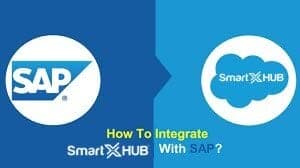- Solutions
- Industries
- IoT Platform
asset management
security
- Resources
Resources
Products
Success Stories
RTLS Fundamentals
- Blog
- About
- En-US
The purpose of this blog is to serve as a central point of entry through which we would like to provide you with information and various aspects of the integration framework for SAP.
In a daily business life, the subject of integration plays an increasingly important role. Integration affects many areas of a company, such as business cooperation, integration of employees from other countries, connecting business units, and a very important aspect is the integration of different software systems and components that best enhance your company processes.
In this blog, we will specifically look at the topic of integrating software systems and components to show how they can be connected for data exchange. Especially in times of digitalization, companies are increasingly facing the challenge of how to connect different software components, such as different systems, mobile applications, integration of sensors, and other technologies to become a more automated, intelligent and connected company.

SmartX HUB is a very open and flexible Asset Management system that offers various possibilities of data exchange across system boundaries.
For data exchange with SAP, this interface, so called Application Programming Interfaces (APIs), are present in the system:
SmartX HUB API
The SmartX HUB API contains objects and methods that enable developers to read, write, update, and remove data objects on database level, including master data.
The integration framework for SmartX HUB is a SOAP based solution to design integration flows for exchanging data between different systems.
In contrast to the classic integration of software components through in-house development and direct use of the existing API’s, various components / services already exist in the integration framework that simplify integration tasks, such as integration services, security functions, message flow control and monitoring, error handling, easy adjustment when APIs change, a light-weight business process management and more.
The integration framework for SmartX HUB is an integral part of Smartx’s asset management and logistics solutions and can be used in every customer installation whatever the installation is, on premise or in the cloud.
The integration framework provides an infrastructure that allows for the communication and interaction between software applications such as SAP solutions, as well as non-SAP systems; whether they are cloud applications or on-premise applications.
The purpose of the integration framework is to provide data mapping and transformed information to the software applications involved. This means that definitions are provided for sender- and receiver systems, the mapping of data and their values, which data is to be exchanged, the specified time intervals or prompts for when the data exchange should take place, and much more.
Knowledge of IT, XML, JavaScript as well as basic SQL, and a general understanding of the data structure of SmartX HUB are sufficient.
SOAP ( Simple Object Access Protocol) is a message protocol that allows distributed elements of an application to communicate. SOAP can be carried over a variety of lower-level protocols, including the web-related Hypertext Transfer Protocol (HTTP). SOAP defines a header structure that identifies the actions that various SOAP nodes are expected to take on the message, in addition to a payload structure for carrying information. The concept of routing a message through a string of nodes that perform different functions is how SOAP supports things like addressing, security and format-independence. Essentially, the headers identify roles, which in turn provide the SOA features which SOAP then routes to. Stringing messages through a sequence of steps is uncommon in today’s microservice-centric development environments.
SOAP is an integral part of the service-oriented architecture (SOA) and the Web services specifications associated with SOA. Because it allows the sender to create a message route based on the logical services that have to be applied to the message on the way to its destination, it lends itself to providing secure and compliant connections, controlling access, offering reliable delivery and failure recovery, and supporting dynamic service discovery. SOA without SOAP is difficult to imagine.
The Company runs 10 APIs to connect SAP to Smartx HUB. The basic interfaces exchange data below:
The Company runs the RFID Printers to create a Smart Labels for drugs. The basic interfaces exchange data below:
Organizations large and small and across industries can leverage RTLS to improve safety, safeguard materials and work more efficiently.
Discover how your peers are benefiting from real-time visibility.
©2014-2024 All Rights Reserved. SmartX Technology Inc